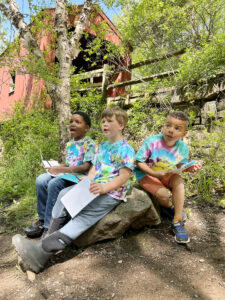 “Come back! We want you to stay!” echoed through the woods near the Mill River this May, as our kindergarten students released the trout they had raised since January. What had started as a classroom science project ended with muddy shoes, wide eyes, and a powerful lesson about life, ecosystems, and the students’ own role in caring for the world.
“Come back! We want you to stay!” echoed through the woods near the Mill River this May, as our kindergarten students released the trout they had raised since January. What had started as a classroom science project ended with muddy shoes, wide eyes, and a powerful lesson about life, ecosystems, and the students’ own role in caring for the world.
Every year, the kindergarten classroom at St. Thomas’s Day School transforms into something extraordinary: a trout hatchery. As part of our partnership with Trout in the Classroom (TIC), students raise brown trout from fragile eggs to fingerlings (juvenile fish), then release them into local waterways. It’s more than a fun project—it’s science education in its most meaningful form.
Through this hands-on experience, students witness how living things grow and change. They learn that science isn’t just about facts—it’s about observation, responsibility, and understanding our interconnectedness with the environment. As they care for the trout, students begin to care for the river. This connection between classroom and ecosystem plants the early seeds of environmental stewardship.
 In January, Ms. Clark, Kindergarten Head Teacher, ceremoniously removed the sign: “Trout Eggs Coming in January” from the glass tank in the classroom. Sixteen excited students gathered around as 200 tiny trout eggs arrived. With noses pressed to the glass, they watched as Ms. Clark gently transferred them into a small hatching basket, which is placed inside the tank but sits closer to the top. This basket helps keep the eggs in one place and lets the students observe them more easily. From that moment on, the students became scientists.
In January, Ms. Clark, Kindergarten Head Teacher, ceremoniously removed the sign: “Trout Eggs Coming in January” from the glass tank in the classroom. Sixteen excited students gathered around as 200 tiny trout eggs arrived. With noses pressed to the glass, they watched as Ms. Clark gently transferred them into a small hatching basket, which is placed inside the tank but sits closer to the top. This basket helps keep the eggs in one place and lets the students observe them more easily. From that moment on, the students became scientists.
There was a lot of quiet curiosity – students whispered questions or pointed out details in the little orange eggs. With teacher guidance, each student steps up onto a small stool and peeks into the hatching basket. They made their first entry into their trout journals by simply drawing what they saw, and some students added labels and writing. As the eggs hatched into sac fry and then into tiny swimming fish, the students became daily caretakers. “Trout Keeper” became a coveted role. Each day, a student would log water temperature and pH levels, check the filter, chiller, and air stone, and observe water clarity. “I liked having our trout jobs,” said Liam, a kindergarten student. “It was fun using the test strip to test the pH levels of the water!” Their curiosity grew with the trout.
As the days passed, small black eyes appeared inside the eggs. “The first time a student spotted a wiggling alevin (a newly spawned trout still carrying the yolk), it was magical!” added Ms. Clark. Using a camera that is connected to the classroom Touch It screen, teachers projected the view into the tank to get a closer look. The energy in the room shifts from waiting to observing. Some students gave the tiny alevin names.
 The excitement built to a crescendo in May, when students, teachers, and parent chaperones walked to the Mill River for the long-awaited release. Children skipped ahead eager to release their new ‘friends’ but the moment was bittersweet. “This is where they belong,” teachers reminded them. “They’ll be happy here.” With questions, laughter and quiet reverence, the trout were released—and science became real.
The excitement built to a crescendo in May, when students, teachers, and parent chaperones walked to the Mill River for the long-awaited release. Children skipped ahead eager to release their new ‘friends’ but the moment was bittersweet. “This is where they belong,” teachers reminded them. “They’ll be happy here.” With questions, laughter and quiet reverence, the trout were released—and science became real.
This project shows that when science is lived and experienced, it sticks. Students don’t just learn what fish need to survive—they learn why it matters. They gain insight into ecosystems, data collection, and life cycles. More importantly, they begin to see themselves as caretakers of their world.
